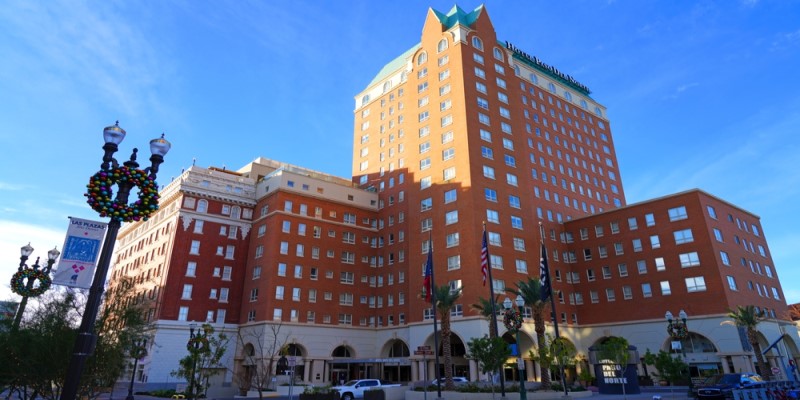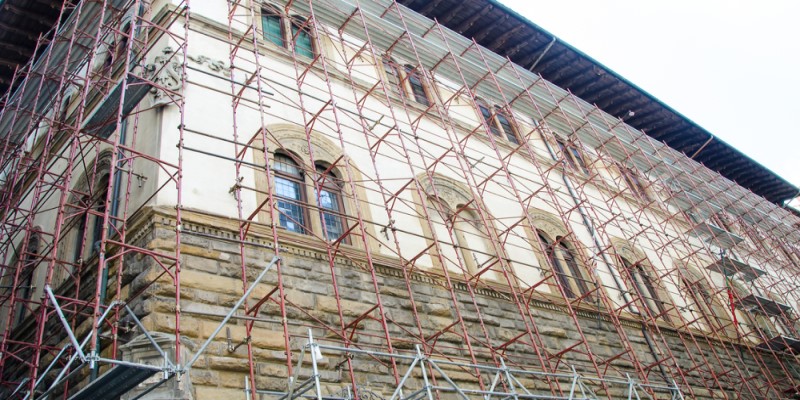
By Anayat Durrani
When Hotel Paso del Norte opened its doors in El Paso, Texas in 1912, it was known as the “million dollar hotel.” But over the years, the hotel fell into disrepair. It was eventually added to the National Register of Historic Places on January 5, 1979. But, in October 2016, The Meyers Group bought the building and the newly renovated hotel officially re-opened in October 2020, thanks in part to the EB-5 program, which helped fund the revitalization of the historic hotel.
The project reportedly cost $70 million, created more than 1,000 jobs and has helped to boost cultural tourism and the local economy.
“Investing EB-5 funding in a historic redevelopment benefits both EB-5 investors and the project,” says Dan Wycklendt, president of FirstPathway Partners. “The obvious upfront benefit is the reduction in overall cost of the project, added equity, and security derived from the use of the historic tax credits, but the hidden value is, if done correctly, reuse often creates a better “end product” that far exceeds new construction.”
Wycklendt says the old saying, that “They don’t make them like they used to” is especially true when dealing with historic buildings.
“These buildings often contain historically significant architectural details, quality historic hand-crafted materials, and often a volume of space that would be cost prohibitive to build today,” says Wycklendt. “This produces a high-end building that can command higher rents, higher occupancy, and lower turnover compared to new construction, while still achieving the sustainability and LEED certification that comes from rehabilitation.”
The EB-5 program’s role with rehabilitated historic buildings
The EB-5 program has helped fund a number of rehabilitated historic buildings nationwide. Financing historic real estate projects typically involves using various sources of equity such as state tax credits, new markets tax credits, federal historic tax credits and increasingly EB-5 funding.
“Generally, historic buildings would be able to benefit of the use of Historic Tax Credits as a source of capital,” says Roy Carrasquillo, managing shareholder of Carrasquillo Law Group P.C. “In addition to HTCs, these projects can also benefit from incorporating EB-5 financing as a portion of their source of funds, particularly as EB-5 financing can also become a source of gap financing for projects taking advantage of these tax programs.”
The two-story Citizen News Building in Hollywood, California was built between 1930 and 1931 in the Art Deco architectural style. The building once served as the headquarters for the Hollywood Citizen-News, until the paper shut down in 1970. In 2006, the building reportedly had a multimillion-dollar renovation and now functions as a nightclub/lounge, has two restaurants, and two floors of commercial office and event space. Relevant Group used EB-5 financing for the project. The building was designated a Los Angeles Historic-Cultural Monument in 2018.
“If the cost of a historic project utilizing tax credits, is the same or less than new construction, tax credits can be a useful tool to incentivize developers to choose a historic rehab vs. building new,” says Wycklendt.
For EB-5 investors, the other advantage in a historic tax credit project, Wycklendt says, “is the increased oversight from lenders, historic tax credit investors, and the National Parks Service, which ensures the developer builds a high quality, financially feasible project.”

Historical buildings that used EB-5 funding
The Global Water Center in Milwaukee, Wisconsin used EB-5 funding from FirstPathway Partners, with tax exempt bonds, new market tax credits, historic tax credits, and other investment to breathe new life into a historic vacant manufacturing building originally built in 1904. The building was transformed into a globally awarded cutting-edge incubator 99% leased and occupied by universities and water technology companies.
“Not only did it become a catalyst for redevelopment throughout the National Historic district, but it was also a success for EB-5 investors. The investors gained permanent residence and saw their full investment returned with Preferred Returns,” says Wycklendt.
Ziock Building in downtown Rockford, Illinois, was a former factory built between 1912-1950. The 13-story industrial building was abandoned for nearly 25 years. The original part of the structure is 107 years old and the building was given landmark status on May 13, 2011. The building was renovated into the Embassy Suites by Hilton Rockford Riverfront in 2020. Wisconsin-based Gorman & Company Inc. is the developer who reportedly came up with $87.5 million to convert the building with some $30 million of the enterprise financed by 60 investors from China, India and Vietnam.
Carrasquillo says his firm is in the process of evaluating a hotel development involving a historical building which is incorporating HTCs and traditional financing, which seeks to incorporate EB-5 to make the project financially viable.
“EB-5 financing can interact with HTCs and other tax credits, making projects financially viable and attractive to developers who otherwise may stay away from these types of projects,” says Carrasquillo. “Developments involving historic buildings generally incorporate increased construction and development costs, which EB-5 financing helps in making a difference.”
There’s also the 1957 Houston Medical Towers office building that was transformed into the Westin Hotel at Texas Medical Center in 2019. CanAm Enterprises made the $20 million EB-5 investment to help finance the renovation of the 19-story historic building located directly adjacent to the Texas Medical Center in Houston, Texas. It was renovated into a 272-suite, approximately 210,000 square foot full-service hotel under the Westin brand. It’s listed on the National Register of Historic Places. The rehabilitation of Medical Towers building reportedly created over 1,200 jobs in construction and operations.
Carrasquillo says the EB-5 program can be utilized for the rehabilitation of historic buildings in a number of ways, such as providing access to capital. He says rehabilitating historic buildings can be expensive because these types of structures need specialized materials, skilled labor, and adherence to preservation guidelines.
“The EB-5 program provides a source of funding for these projects by attracting foreign investors seeking residency in the U.S.,” says Carrasquillo.
There are also economic benefits, he says, since the investment in preserving and restoring a historic building can stimulate local economies by creating jobs, attracting tourism, and raising property values in the local area in certain urban regions that may have difficulty with securing financing.
Redevelopment of Houston’s historic Melrose Building, a 21-story building located in Houston’s central business district is another EB-5 funded project. The building opened in 1952, was abandoned in the 1990s and was Houston’s first modern-style skyscraper. It has since been added to the National Register of Historic Places. The project reportedly cost between $75 to $80 million. Atlantic American’s Fortune Fund 1 raised $14,000,000 investment from EB-5 investors in the redevelopment of the office building turning it into the Le Méridien Houston Downtown, a Marriott lifestyle brand.
Since many historic buildings are truly built to last and are steeped in a town’s history, the EB-5 program can also be utilized for cultural preservation. Restoration of these historic buildings can have lasting benefits and significance in the local communities they are located in.
“Communities can preserve their cultural heritage, ensuring that these landmarks continue to serve as symbols of their history and identity for future generations,” says Carrasquillo.
DISCLAIMER: The views expressed in this article are solely the views of the author and do not necessarily represent the views of the publisher, its employees. or its affiliates. The information found on this website is intended to be general information; it is not legal or financial advice. Specific legal or financial advice can only be given by a licensed professional with full knowledge of all the facts and circumstances of your particular situation. You should seek consultation with legal, immigration, and financial experts prior to participating in the EB-5 program Posting a question on this website does not create an attorney-client relationship. All questions you post will be available to the public; do not include confidential information in your question.








